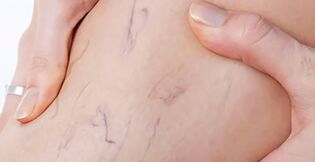
Small protruding veins aren't intimidating yet, but should give you pause!
The initial stages of the disease are characterized by mild symptoms. However, a health conscious woman should not lose sight of these early signs of varicose veins development:
- heaviness in the legs at the end of the day;
- swelling of the feet;
- the appearance of pigmentation on the skin of the lower legs and thinning of the skin;
- numbness in the limbs, frequent muscle cramps in the legs;
- protrusion of the veins above the surface of the skin;
- the appearance of a pattern of veins, spider veins on the legs.
If, upon returning home from a day's work, a woman finds her legs in a "terrible state", one should not blame just uncomfortable shoes or an extra "salty bite" at dinner. Swelling and heaviness of the legs are the first signal of the development of stagnation of blood in the vessels. Remember that venous disease is difficult to treat. Early prevention and timely medical care can stop or significantly slow down the process of stretching the veins. Treatment should be started as soon as possible.
Grade 1 varicose veins
The main causes of varicose veins are considered to be pregnancy, excessive weight gain, prolonged physical activity, a sedentary lifestyle, as well as a genetic predisposition to such a disease. Common people called varicose veins "the hostess disease" because of the peculiarities of this profession and long standing. This degree of disease is the lightest.

Classify the disease according to different factors. One of the classifications is based on the stages of development of the disease:
- Varicose veins of the 1st degree or stage of compensation.
- Grade 2 varices or stage of undercompensation.
- Grade 3 varicose veins or stage of deconpensation.
The different stages of varicose veins in the lower extremities have a radically different treatment. You shouldn't try to cope with the disease yourself. This can only harm and lead to dire consequences. It is best to seek help from a knowledgeable professional.
The first degree of varicose veins is characterized by edema at night, nocturnal convulsive spasms. Often people confuse all of these symptoms with ordinary fatigue. However, already at this stage, it is necessary to take preventive measures, including warming the feet to improve overall blood circulation, light foot massage, regular swimming, cycling.
Varicose veins of the first stage can also manifest as cramps in the calf area, patients often complain of a feeling of stretching in the legs or burning in the muscles. This is more and more often accompanied by pain in the lower limbs.
Already at this stage, manifestations of the visual character of varicose veins can be noticeable, which should immediately alert:
- Slight cyanosis of the skin.
- The first spider veins appear on various parts of the body, most often on the legs.
- Visible tortuosity of the veins.
Varicose veins of the first degree are most often manifested by such external changes.
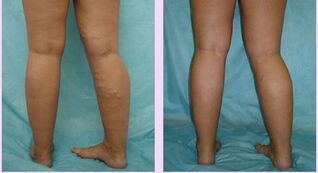
Another important factor in the manifestation of the first stage of varicose veins is the external conditions in which a person finds himself. For example, in a hot environment, symptoms increase, swelling, pain, and spasms increase.
Treatment of first degree varicose veins
Sometimes doctors recommend the addition of venotonics, which are very effective in treating first-stage varicose veins. Separately, it should be said about massage: not all of these types of therapy are suitable for this disease. If after the procedures the pain only intensifies, it is necessary to change the approach to the choice of the massage complex.
It is worth organizing a cool and relaxing foot bath more often, which will soothe the muscles, relieve swelling, help reduce pain and eliminate fatigue. But hot baths should be excluded, since they do not improve the condition of the limbs with varicose veins.
Doctors may recommend the following treatments for this grade of varicose veins:
- Sclerotherapy - a special medicine is injected directly into a vein with a needle. The action of the drug is aimed at resorption of the veins, strengthening of weak vascular walls, blocking of blood flow to the desired area.
- Ozone therapy - an action aimed at strengthening blood vessels, resorption of varicose asterisks.
Each of the above options is quite effective. However, the maximum effect can only be achieved if all the recommendations that should be followed after the procedures are used.
Wearing special compression garments is essential. Such an element helps to create pressure in the veins, thus preventing them from expanding further.
Causes of the disease
There are more than fifty reasons that can trigger a change in the venous system. People whose profession is associated with stress on the legs and sedentary activity are particularly susceptible to the disease: salespeople, hairdressers, programmers, accountants, drivers.
Scientists have conducted many years of research and identified the main factors that cause varicose changes:
- Hormonal changes in the body: pregnancy, menopause, adolescence;
- Obesity of all degrees;
- Genetic predisposition. 70% of children whose parents suffered from venous insufficiency develop varicose veins;
- Weak muscle system;
- Wear uncomfortable underwear: socks with tight elastic bands, tight pants for men;
- Lack of activity and physical activity;
- The habit of sitting with one leg over the other;
- Rare change in body position: standing, lying, sitting;
Chronic diseases: diabetes mellitus, high blood viscosity.
Of the ten patients with varicose veins, eight are women. The weaker sex is subject to venous pathologies due to forced hormonal disturbances during pregnancy, after childbirth, during menopause. The second big factor that makes women suffer from leg pain more often than men is the love of high heels.
Rules and guidelines
At the initial stage of varicose veins, the patient is advised to follow the rules:
- Walk once or twice a day. You should walk at a calm pace, stopping periodically to rest.
- Wear comfortable shoes with heels no higher than 3 cm. The upper part of the shoes should not have a pulling device, the laces are not tied as tightly as possible.
- Attend gym sessions twice a week. The loads are selected individually by a doctor and a trainer.
Review your diet. Foods high in sugar, fatty meats, flour products and starches are excluded from foods. Most of the diet of a patient with varicose veins consists of steamed or boiled vegetables. Fried and spicy foods are not recommended.
- The legs should rest in the evening. The blood output will increase if you lift your legs and throw them on a high pillow or on the back of a sofa.
- If the work involves a small amount of movement, it is recommended to lubricate the feet with cooling gels or ointments containing heparin.
- Special compression garments or elastic bandages are used every day. Special underwear is selected by a doctor. The special feature of compression garments is the compression function. The pressure on the body occurs with varying force, which forces the blood to flow forcibly.
- Change your position often. If you constantly have to sit down at work, get up and sit down a few times every 30 minutes. Exercise will help prevent varicose veins and hemorrhoids.
Processing of the different steps
Effective therapy in the early stages may have the opposite effect in advanced pathology. The choice of treatment methods should be adapted to the stages of varicose veins:
Compression jersey
It is used in all stages of varicose veins, however, the degree of compression should differ significantly at different stages of disease progression. At the initial stage of varicose veins, compression is used for prophylactic purposes during standing and sedentary labor.
Compression can stop the development of varicose veins, but before any medical use it is necessary to consult a phlebologist, since the compression is dangerous, aggravating the problem of venous outflow. At the stages of compensation and under-compensation of puffiness and visible varicose veins, underwear of the first and second classes of compression is usually prescribed.
The third class of compression is used in severe venous insufficiency. In case of lymphatic edema, use fourth grade underwear. The hospital jersey is worn for hospital treatment.
Folk remedies
Traditional medicine helps to treat varicose veins at an early stage. The following tools are widely used:
- cabbage leaf application
- compresses of potatoes, wormwood and garlic;
- chestnut tinctures,
- decoctions of hops and nettles.
However, the ease of use, accessibility, smoothness of action of folk remedies is combined with their low efficiency (compared to drugs), therefore, enthusiasm for these methods is heavydisease progression. Herbal medicine and compresses should be applied after medical advice and only serve as an auxiliary to the main treatment.
Hirudotherapy
Treatment with leeches is indicated in rare cases of advanced stages of varicose veins. Sometimes leeches are prescribed for thrombophlebitis.
Leeches can cause allergies and trophic ulcers which make varicose veins worse. Currently, the method is supplanted by non-traumatic drugs that contain anticoagulant components.
Drugs
Medication can help relieve symptoms. Tablets, capsules based on extract of grapes, chestnuts, which are biologically active additives, are effective at the initial stage of varicose veins.
Aid is prescribed at the compensation stage. Most ointments and gels contain heparin, which prevents blood from clotting. To a large extent, the effect of ointments and gels is caused by massaging during application.
But at the stage of decompensation, the application of such products can cause additional skin manifestations. Relief of symptoms with medication is often temporary and does not address the underlying cause.
Operations
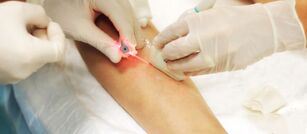
Laser coagulation and sclerotherapy are minimally invasive techniques for excluding veins from the bloodstream. They are used for small diameters of dilated veins in the initial stages of varicose veins (when removing spider veins, threads).
Endovasal laser coagulation of varicose veins
Phlebectomy
Surgical removal of the veins is indicated in the third stage of the disease, accompanied by trophic ulcers and complications. In some cases, varicose veins in the legs do not develop according to the pattern presented in the staged classification. For example, the symptoms of the first stage may be completely absent: an image of undercompensation appears immediately.
Or, as the disease progresses, some signs of varicose veins do not add to the symptoms of the previous stage, but go away. Therefore, at the beginning of the 21st century, Russian phlebologists, in addition to the stepwise approach, adopted the International Classification (CEAP), in which, when diagnosing the severity of the disease, the facts of the individual characteristics ofthe evolution of varicose veins and the effects of treatment are taken into account.
Symptoms
The symptoms of the pathology with the onset of varicose veins do not suggest venous diseases:
- feeling of heaviness in the legs;
- tired after walking.
They tend to be associated with flat feet, unusual high heels, uncomfortable new shoes, lumbar osteochondrosis.
And only visual detection of dilated cyanotic veins under the skin allows us to suspect the development of varicose veins.
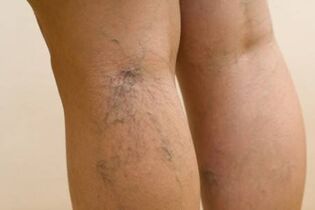
The vascular mesh as the first sign of varicose veins most often appears below the knees
Women go to the doctor when they notice unpleasant cosmetic blemishes in the form of reddish venous "spiders" on the legs, under the knees, on the skin of the thighs.
The "influx" of young women seeking treatment from a venous phlebologist is usually associated with the upcoming summer beach season, which is looking after their appearance rather than their health. With the help of pills, they want to restore the beauty of the skin of the legs.
Pregnant women pay more attention to their condition. In addition to cosmetic changes, they note difficulty in walking, increased fatigue in the evening.
The initial stage of the disease is indicated by the disappearance of clinical symptoms after lying down.
You can be sure by doing this experiment: measure the volume of the lower leg at the ankles or calf muscles in the morning and evening after work. If the difference is more than 1 cm, there are signs of initial varicose veins.
Then appear:
- pain in the legs;
- swelling of the feet;
- feeling of fullness and heaviness in the legs;
- muscle cramps at night; The dilated
- veins become like dense "serpent" cords with dark areas of the skin.
These signs are indisputable manifestations of venous insufficiency and require treatment.
The main causes of varicose veins in women
Fatigue and swelling may be the first signs of a venous blood flow disorder
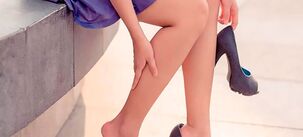
The sex hormone estrogen plays a special role in the development of varicose veins in women. Its action leads to disorders such as weight gain, depression, swelling, drowsiness, dry mucous membranes. This hormone increases the permeability of small vessels. Fluid easily leaves the bloodstream, the blood becomes less fluid. The excess fluid accumulates in the surrounding tissue. These factors contribute to the development of stagnation of the vessels of the lower extremities.
Reasons for increased estrogen in women:
- An imbalance in the production of estrogen-progesterone. It occurs as a result of a decrease in the level of progesterone in a woman's body;
- Chronic stress. During stress, the body produces cortisol, which in turn inhibits the synthesis of progesterone;
- Pregnancy. During pregnancy, the amount of estrogen in a woman's body increases;
- Take contraceptives. Varicose veins are a side effect of taking these medications;
- Liver disease, because estrogen is eliminated from the body by the liver. With its poor function, this hormone accumulates in the body;
- Age-related hormonal changes also lead to an imbalance of sex hormones with a predominance of estrogen.
Separately, the reasons for the development of varicose veins should be noted overweight and genetic predisposition to this disease. If being overweight can and should be combated for general health, then genetic predisposition cannot be avoided. As a result of these factors, varicose veins have become significantly “younger” and now often occur in girls between the ages of 16 and 20.
Complete liver function is important to maintain normal hormonal levels. In addition to eliminating excess hormones, it participates in the synthesis of substances - precursors of progesterone and estrogen. To improve one's work, physical activity, good nutrition and minimizing the intake of toxic substances in the body are necessary.
Treatment of varicose veins with traditional medicine
Treatment of varicose veins in the legs with medication is the most effective and suitable for almost all patients. A wide range of drugs allows you to choose a more suitable drug for long-term treatment.
Medicinal methods to treat varicose veins in the legs
Venotonics are among the most effective drugs for the treatment of this disease. Venotonics are drugs that help increase the tone of the veins and better blood flow from the veins.
These tablets can prevent the formation of varicose veins and characteristic nodules.
Application of ointments
The best treatment for varicose veins in the legs is an integrated approach, which includes medication in the form of tablets, as well as the use of gels and ointments for external treatment of problem areas.
Ointment for varicose veins on the legs also helps to improve blood circulation and prevent blood clots.
These funds are recommended for use only after consulting a doctor, who will also determine the duration of treatment and the scheme of use.
Do not self-medicate - this can further harm the patient's already poor condition.
Consequences of varicose veins.
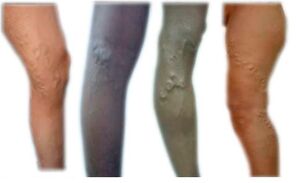
Varicose veins can lead to the development of trophic ulcers on the leg, thrombosis in the varicose system, thrombophlebitis, pulmonary embolism (instant death) in the midst of seemingly complete health.
The complicated stages of varicose veins require surgery. While women most often suffer from varicose veins, men are also affected by this disease, mainly for hereditary reasons.
A man under the age of 40 may appear on the operating table, and drastic measures are used to cure him of varicose veins - diseased veins are removed.
It is easy to remove varicose veins.
In the groin, the surgeon makes an incision, where the large saphenous vein affected by varicose veins empties into the femoral vein. The vein is exposed, tied and excised, and a second incision is made at the ankle. With the help of a special metal probe, which is inserted into the lumen of the vessel, the entire enlarged vein is removed.
In the future, with the appropriate technology of the operation, relapses are not observed. The blood supply to the leg is distributed to other vessels, and after 2 weeks everything is fully restored.
Risk factors predisposing to the development of varicose veins.
- Genetics and pathology of connective tissue;
- Woman;
- Taking hormonal drugs: progesterone, estrogen;
- Pregnancy;
- Age: more frequent after 50 years;
- Overweight and physical inactivity;
- Extended stay in an upright position (standing work: hairdressers, sales staff, teachers, etc. );
- Obesity.
Symptoms and signs of varicose veins and chronic venous insufficiency.
| Symptoms of varicose veins | External signs |
| Painful pains | Telangiectasia |
| Heavy legs | Reticular veins |
| Fatigue | Varicose veins |
| Puffiness | Thrombophlebitis |
| Itchy skin | Hyperpigmentation |
| Discomfort in the legs | Trauma knot bleeding |
| Cramps in the calf muscles | Ulceration |
Varicose vein treatment options.
The choice of treatment depends on the diameter and type of varicose veins
- Varicose veins of saphenous veins
- Drug treatment
- Elastic compression and leg bandage
- Injection sclerotherapy
- Foam sclerotherapy
- Laser therapy
- Miniflebectomy
Dear women, varicose veins can envelop you in long skirts and pants forever. If the pills and ointments fail to get your legs back to normal, the only sure way to get rid of the dilated veins remains. How and where, only after consultation with a specialist phlebologist. Veins can now be treated surgically without hospitalization, without anesthesia, without incisions, with great precision. You just need to take a step towards your health.
Detailed information on varicose veins, symptoms, disease prevention, special exercises, treatment methods and necessary nutrition can be found on the website: ovaricoze. ru
How varicose veins manifest in the early stages. Why is it dangerous
As a rule, reticular varicose veins are painless. Therefore, the most frequent complaints that patients turn to doctors are cosmetic defects - visible reticular veins.
In more rare cases, the appearance of such a varicose mesh is accompanied by a burning sensation or other changes in skin sensitivity.
In addition to these symptoms, the first stage of varicose veins is manifested:
- heaviness in the legs;
- increased leg fatigue;
- cramps in the muscles of the lower extremities, especially at night;
- itching at the site of the appearance of the vascular network;
- swelling of the feet and legs.
In order to prevent the progression of the disease, it is necessary to start treatment in time
Therefore, it is important to visit a phlebologist, angiologist or vascular surgeon in a timely manner, who will tell you what to do with such skin formations. To begin with, a specialist will conduct an examination and prescribe the necessary additional examinations that will help identify the causes of the appearance of asterisks or meshes, as well as establish the degree of impaired venous circulation
To determine the degree of vascular lesions and their insufficiency, do the following:
- complete blood count (indicates whether the patient has anemia or thrombocytopenia);
- biochemical blood test (detects blood clotting disorders or liver and kidney function);
- general urinalysis (detects kidney problems);
- vascular ultrasound - duplex angioscanning (reveals pathology of the vascular wall and blood flow disorders);
- X-ray venography with contrast (determines the location of venous lesions and the degree of impairment of their functions).
If you do nothing after you detect the first signs of reticular varicose veins, it is possible:
- accession of inflammation and development of thrombophlebitis of superficial veins of the lower extremities;
- transition of the pathological process from the superficial veins of the lower extremities to the deep veins;
- thrombosis of the venous vessels. If thrombosis occurs in the venous vessels of the head, it is dangerous for strokes and sinus thrombosis; Thromboembolism
- of pulmonary arteries is a life-threatening complication that occurs due to the separation of a blood clot from the vessel wall and blockage of the lumen of the pulmonary arteries.
If you ignore the appearance of incipient reticular varicose veins and do not start treatment on time, the disease will progress. Then the development of complications will become inevitable.
Prevention
Don't forget about preventive measures. For prevention, you need to devote time to sports.
Avoid excessive physical activity. Wear comfortable shoes with low heels (up to 4 cm). Remember that hot baths, baths, and saunas have an adverse effect on the health of the legs.
And following these simple guidelines will help prevent the development of this disease:
- try to get rid of bad habits - drinking and smoking negatively affects the condition of your blood vessels;
- compression therapy - wear medical stockings, tights and knee socks;
- diet, weight control (overweight people are more likely to suffer from varicose veins), exclude fatty meats and poultry, forgo spicy and salty foods, be sure to include vegetables and fruits indiet; Massage
- - get into the habit of doing a light foot massage after a hard day's work, it will help you relax and improve the body's natural blood circulation.
Any disease is always easier to prevent than to cure. To be in a good health!












































